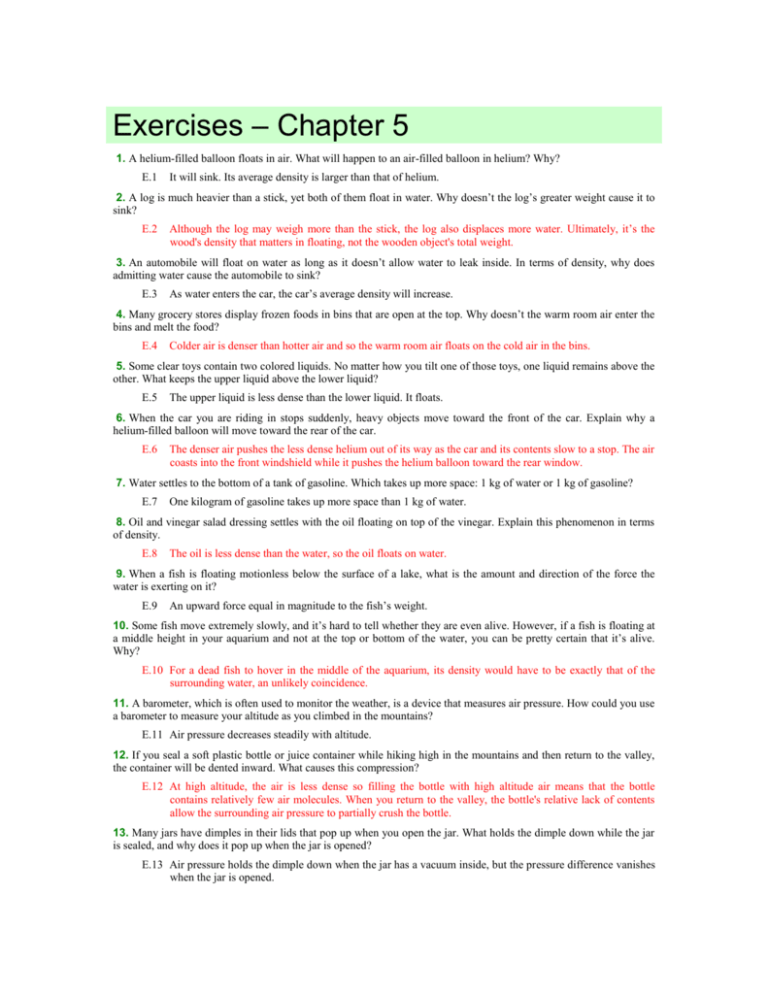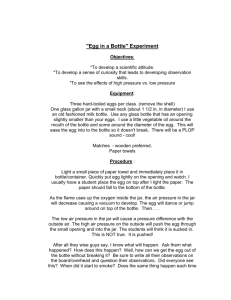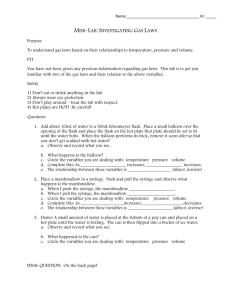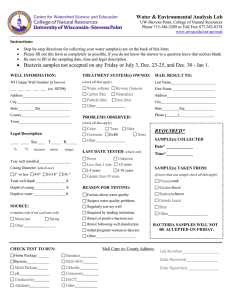Exercises – Chapter 5
advertisement

Exercises – Chapter 5 1. A helium-filled balloon floats in air. What will happen to an air-filled balloon in helium? Why? E.1 It will sink. Its average density is larger than that of helium. 2. A log is much heavier than a stick, yet both of them float in water. Why doesn’t the log’s greater weight cause it to sink? E.2 Although the log may weigh more than the stick, the log also displaces more water. Ultimately, it’s the wood's density that matters in floating, not the wooden object's total weight. 3. An automobile will float on water as long as it doesn’t allow water to leak inside. In terms of density, why does admitting water cause the automobile to sink? E.3 As water enters the car, the car’s average density will increase. 4. Many grocery stores display frozen foods in bins that are open at the top. Why doesn’t the warm room air enter the bins and melt the food? E.4 Colder air is denser than hotter air and so the warm room air floats on the cold air in the bins. 5. Some clear toys contain two colored liquids. No matter how you tilt one of those toys, one liquid remains above the other. What keeps the upper liquid above the lower liquid? E.5 The upper liquid is less dense than the lower liquid. It floats. 6. When the car you are riding in stops suddenly, heavy objects move toward the front of the car. Explain why a helium-filled balloon will move toward the rear of the car. E.6 The denser air pushes the less dense helium out of its way as the car and its contents slow to a stop. The air coasts into the front windshield while it pushes the helium balloon toward the rear window. 7. Water settles to the bottom of a tank of gasoline. Which takes up more space: 1 kg of water or 1 kg of gasoline? E.7 One kilogram of gasoline takes up more space than 1 kg of water. 8. Oil and vinegar salad dressing settles with the oil floating on top of the vinegar. Explain this phenomenon in terms of density. E.8 The oil is less dense than the water, so the oil floats on water. 9. When a fish is floating motionless below the surface of a lake, what is the amount and direction of the force the water is exerting on it? E.9 An upward force equal in magnitude to the fish’s weight. 10. Some fish move extremely slowly, and it’s hard to tell whether they are even alive. However, if a fish is floating at a middle height in your aquarium and not at the top or bottom of the water, you can be pretty certain that it’s alive. Why? E.10 For a dead fish to hover in the middle of the aquarium, its density would have to be exactly that of the surrounding water, an unlikely coincidence. 11. A barometer, which is often used to monitor the weather, is a device that measures air pressure. How could you use a barometer to measure your altitude as you climbed in the mountains? E.11 Air pressure decreases steadily with altitude. 12. If you seal a soft plastic bottle or juice container while hiking high in the mountains and then return to the valley, the container will be dented inward. What causes this compression? E.12 At high altitude, the air is less dense so filling the bottle with high altitude air means that the bottle contains relatively few air molecules. When you return to the valley, the bottle's relative lack of contents allow the surrounding air pressure to partially crush the bottle. 13. Many jars have dimples in their lids that pop up when you open the jar. What holds the dimple down while the jar is sealed, and why does it pop up when the jar is opened? E.13 Air pressure holds the dimple down when the jar has a vacuum inside, but the pressure difference vanishes when the jar is opened. 14. If you place a hot, wet cup upside down on a smooth counter for a few seconds, you may find it difficult to lift up again. What is holding that cup down on the counter? E.14 When the air inside the cup cools, its pressure drops. The pressure imbalance between atmospheric pressure outside and partial vacuum inside the cup produces inward forces on the cup. These ultimately push the cup against the counter. 15. You seal a rigid container that is half full of hot food and put it in the refrigerator. Why is the container’s lid bowed inward when you look at it later? E.15 Cooling the air in the container reduced its pressure. The resulting pressure imbalance across the lid pushes the lid inward. 16. Why aren’t there any thermometers that read temperatures down to -300 ºC? E.16 That temperature is below absolute zero, the lowest possible temperature. 17. You use your breath to inflate a large rubber tube and then ride down a snowy hill on it. After a few minutes in the snow the tube is underinflated. What happened to the air? E.17 As it cooled, the air became more dense. 18. A marshmallow is filled with air bubbles. Why does a marshmallow puff up when you toast it? E.18 As you heat the air inside the marshmallow's bubbles, the pressure increases and the air pushes the each bubble's skin outward. The bubbles grow larger and so does the entire marshmallow. 19. Wasp and hornet sprays proudly advertise just how far they can send insecticide. How does the pressure inside the spray can affect that distance, and why is the direction of the spray important (vertical vs. horizontal)? E.19 Higher pressure in the can produces greater distance of spray. As for direction, the spray won’t travel as far upward because some of its kinetic energy becomes gravitational potential energy on the way up. 20. Ice tea is often dispensed from a large jug with a faucet near the bottom. Why does the speed of tea flowing out of the faucet decrease as the jug empties? E.20 As the level of tea in the jug decreases, the pressure at the faucet decreases and the total energy of tea passing through that faucet decreases. The tea can no longer obtain as much kinetic energy as before and travels more slowly. 21. Why must tall dams be so much thicker at their bases than at their tops? E.21 The pressure imbalance on the base of the dam is larger. 22. Waterproof watches have a maximum depth to which they can safely be taken while swimming. Why? E.22 The deeper the matches go in the water, the greater the surrounding water pressure. Eventually the pressure becomes so high that it deforms the match heads and permits moisture to enter the chemicals, spoiling the matches. 23. When you stand in a pool with water up to your neck, you find that it’s somewhat more difficult to breathe than when you’re out of the water. Why? E.23 The pressure outside your lungs is above atmospheric pressure. 24. How does pushing on the plunger of a syringe cause medicine to flow into a patient through a hollow hypodermic needle? E.24 Pushing on the plunger squeezes the medicine in the syringe and raises its pressure. With a pressure imbalance between this high-pressure medicine and the low pressure in the patient, the medicine accelerates toward the patient and flows into them. 25. Why must the pressure inside a whistle teakettle exceed atmospheric pressure before the whistle can begin to make noise? E.25 Gas only accelerates toward lower pressure. 26. Each time you breathe in, air accelerates toward your nose and lungs. How does the pressure in your lungs compare with that in the surrounding air as you breathe in? E.26 As you breathe in, the pressure in your lungs is less than the surrounding pressure. 27. You can inflate a plastic bag by holding it up so that it catches the wind. Use Bernoulli’s equation to explain this effect. E.27 As wind slows in the bag, its pressure rises and inflates the bag. 28. When someone pulls a fire alarm in a skyscraper, pumps increase the water pressure in the section of the building nearest that alarm box. How does this pressure change assist firefighters who must battle the blaze? E.28 Increasing the local water pressure allows the firefighters to send more water through their hoses and have it travel faster when it leaves their nozzles.











